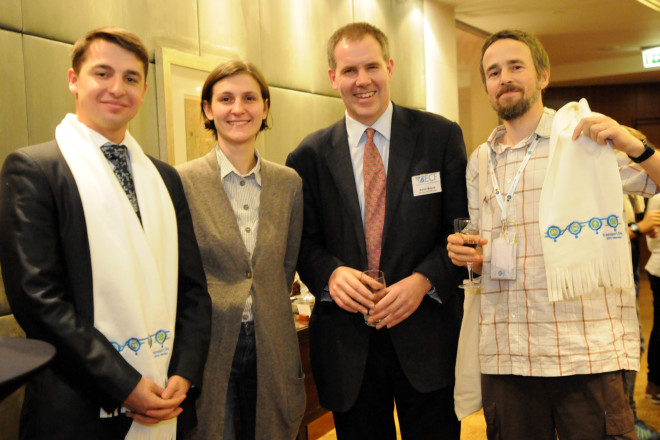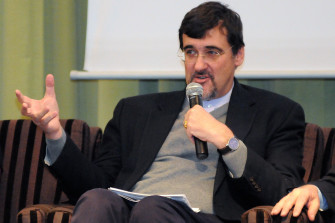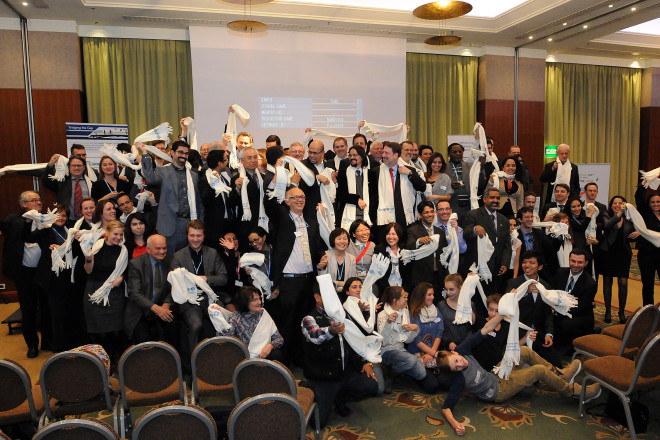
ECF's Kevin Mayne Reflects on Transport Day 2013
ECF's Development Director Kevin Mayne (second from the right) at Transport Day 2013. Photo: www.iisd.ca
ECF Development Director Kevin Mayne reflects on the COP 19 Climate Summit in Warsaw and cycling’s role on the global stage.
Over the past few years ECF has received increasing numbers of invitations to represent cycling at global events for transport, sustainable development and climate change. At the United Nations Framework Convention on Climate Change (UNFCCC) 19th event attempting to bring the nations of the world together to tackle the threats and consequences of human induced climate change, The Partnership on Sustainable Low Carbon Transport (SLOCAT) together with The Bridging the Gap Initiative brought together experts for Transport Day 2013.
Mayne reflects on the economics and human elements of mobility and ECF’s role in this global transport forum. Within the grim reality of the transportation sector’s status in global financial and policy instruments, ECF offers a three-tiered approach to policy makers that could see cycling take a proper place in climate change mitigation processes.
Background: SLOCAT and COP 19
Over the past few years ECF has received increasing numbers of invitations to represent cycling at global events for transport, sustainable development and climate change.
This reflects both the increased need for practical solutions to global problems and the work we have done to give cycling visibility at this level. The need for global solutions has brought together networks of campaigners, academics, policy makers and business leaders who realise that transport is one of the driving forces for the change needed.
The Partnership on Sustainable Low Carbon Transport (SLOCAT) is one of the driving forces for change. Founded in 2009 it has brought together the disparate voices, bringing a consistent case for sustainable transport to the UN and all its agencies. Together with The Bridging the Gap Initiative SLOCAT created the concept of a Transport Day within the UN Climate Change processes.
ECF’s membership of SLOCAT helps to make the case for cycling - other transport modes attract more attention because they attract “big” capital investments from governments and global funders like the international development banks. A European body speaking on this global stage is a bit of an oddity. However on cycling the world looks to “the old continent” for expertise and knowledge because to date it is Europe that has shown the potential to recreate cycling cities from car bound societies. And it is ECF’s Velo-City Global that has proved there is demand for global knowledge sharing on cycling with many of the SLOCAT partners becoming supporters of the conference series.
The Convention of the Parties (COP) in Warsaw was the United Nations Framework Convention on Climate Change (UNFCCC) 19th event attempting to bring the nations of the world together to tackle the threats and consequences of human induced climate change.
There is no room in this report to describe the highs and lows of the COP process. I am a complete newcomer to this world so I was particularly attentive to the experienced voices in SLOCAT about the prospects for COP19. I learned that in the climate change world transport has been poorly incorporated into global action plans, with concentration being on topics like energy production, de-forestation and adaption to change. There are powerful financial instruments to support national and international investments in these fields with so called “polluter” countries and businesses paying money into funds controlled by the UN, the World Bank and a variety of Development Banks which then go to the developing world. Much of the negotiations within the COP process are about the structure and level of these future funds. The numbers seem breathtakingly large to a newcomer – nobody talks about anything less than billions – but in the context of the global risks they are still small and need to grow.
Readers will also know that many of the NGOs walked out of the process just before the final day in sheer frustration at the lack of progress by the national delegations but well before that I didn’t hear much optimism. There was an initial hope that the powerhouses of the global economy, the US and China, are at last taking climate change seriously and the impact of Typhoon Haiyan in the Philippines gave a powerful emotional imperative to the opening sessions. But one by one there were negative announcements from Canada, Japan and Australia, together with concerns about the energy policies of hosts Poland, which took momentum out of the process and little progress was made.
This COP was a stepping stone towards Paris in 2015 which is when a complete Climate Deal is needed so the process is not over but it seems there will need to be some powerful diplomacy in the next two years to see meaningful progress.
Transport Day
This was the second Transport Day organised by SLOCAT at the COP meetings. Away from the gloom of the main COP processes it was clear that this was an altogether more optimistic gathering because there is a different momentum in global transport policy.
The reasons for that lie outside the climate change process.
The first reason is pure economics. The twin trends of global trade and increasing urbanisation have shown that the economies of the future will not be able to function unless they are underpinned by efficient and attractive transport networks. If fuel prices rise rapidly economies without alternatives to the private car will see significant cost pressures on their consumers that are not sustainable and freight networks become unaffordable.
The second element is the human dimension. Whether we call it equality, equity, human rights or sustainable development it is clear that mobility is one of the planet’s greatest social divides. People without mobility are denied access to food, water, healthcare and sanitation. The poor are overwhelmingly the victims of transport related deaths. With huge growth in urbanisation in the developing world, mobility can make the difference between areas becoming suburbs or slums. And beyond the basics of life it is those with mobility who become economically active. Within the middle and professional classes there are demands for quality of life when choosing where to work and where to bring up families. Companies competing for scarce skills are placing their businesses where those employees want to live. Congested cities without rapid transit, metro and attractive streets for walking and cycling are likely to miss out on this international competition.
I was particularly impressed by the contribution of Andre Dzikus, Coordinator of Urban Basic Services from UN-Habitat, the global agency working on the cities of the future. He spoke with passion about policy not just built on pure financial analysis, but with heart and values at its core.
Contributors to Transport Day repeatedly reported that international agencies, national governments and cities were ambitious to improve sustainable transport in all its forms because of these wider benefits. They know that 50% of the world’s population in cities is unsustainable unless we change the way we travel. With this momentum the benefits of reducing carbon emissions can be built in to changes that people desire.
This change is slow. The finance and policy mechanisms for getting climate change funding for transport projects have not worked well in the past. Governments have either not come forward with transport projects or, when they have been proposed, they have not been suitable for the mechanisms which aim to provide billions for measurable actions.
Transport has been much harder to get through these processes because each individual proposal may not deliver enough carbon savings to justify the cost. Transport projects pay their way when you consider the so called co-benefits of transport, in addition to emissions reduction, such as: reductions in congestion, fuel use, air and noise pollution and improvements in road safety, health, productivity, universal access, job creation, city competitiveness and land use.
The hope for the future in the transport sector is an instrument linked to climate change called Nationally Appropriate Mitigation Actions (NAMAs). NAMAs were conceptualized in 2007 but only began to be used in 2012. Countries can create these to demonstrate their national plans for carbon emissions reductions within the COP process and developing countries can use them to apply for funding to take action on climate change.
NAMAs seem more flexible than previous approaches and they can take account of co-benefits. This means national governments can effectively combine a proposal for a new mass transit system on economic grounds with carbon reduction benefits and use it to apply for funding from climate reduction funds. Already some global development banks have financed transport projects in this way, an encouraging sign for the Transport Day delegates.
However there is still a lot of work to do. These are tentative steps within a massive global process and there was an almost universal acknowledgement in the room that the lobby for transport is to be taken forward as a major part of the global emissions agreements in 2015 and beyond.
ECF and others present signed the “Warsaw Declaration” which sets out this case to the UNFCCC in the clearest possible terms. It is still open for signatures by organisations and individuals; you can read and sign it here.
In addition to the conference format of the Transport Day itself, I was proud to represent ECF and its members as one of the promoters of the Climate Ride, organised by the City of Warsaw to celebrate cycling and give publicity and support for Transport Day. Many thanks to our members in Warsaw Cities for Bicycles who set up the liaison with the city and gave me an insight into the world of cycling advocacy in Poland while I was there.
Transport Day has an excellent Virtual Press Room with lots of photographs and content about the agenda and participants.
Cycling and ECF on the world stage
ECF’s presence in this forum has two purposes.
Firstly, and perhaps most important is to give a voice to all the world’s non-motorised travellers. While many spoke about the need for active transport to be considered, there was nobody but ECF actively keeping the voices of our community in the room. I was able to tell the story of the recent cycling ban in Kolkatta as an example of the reality for many cyclists and walkers, driven off the streets in the name of progress rather than valued for their contribution to society. I strongly felt that I was giving a voice to millions of people at Transport Day. The reality is that cycling is often far below the status of rail, public transport and freight in global discussions because these are capital rich industries that countries value as status symbols and economic drivers.
More practically we were able to set out how we envisioned cycling in the global discussions. ECF’s position at the global level mirrors our position in the EU. Cycling can complement all policies and all investments should consider cycling as part of the package, including risks of displacement of cycling by large infrastructure projects.
We maintain our view that cycling should be 10% of all transport investments in order to grow cycling to at least 10% share of trips.
We maintain our view that cycling should be 10% of all transport investments in order to grow cycling to at least 10% share of trips. But what does this might mean in terms of climate change financial instruments? It is almost impossible to imagine a government creating a billion dollar NAMA based entirely on cycling, much as we believe it would be an amazing investment.
One of the reasons this is unlikely is because we just don’t have the institutions to put together such a plan anywhere in the developing world. There are no NGOs, advocates, engineers, city planners or government officials who could envisage and create the case for such a plan and see it given status above politically appealing projects in public transport.
We suggested a three tiered approach to policy makers that could see cycling take a proper place in these processes.
1. Capacity building – a long term investment to build skills, knowledge and competence in active travel in the developing world.
2. Establish the case for cycling as a co-benefit in every transport analysis. Take proven and validated tools like the WHO’s health evaluation tool HEAT and ensure that it is applied to project appraisal.
3. Add a cycling component to every NAMA. Look for road improvements, access to stations and metro, community cohesion and road safety as part of every scheme. The 10% of NAMA funding for cycling doesn’t have to come from stand-alone schemes, it could come from 10% of each budget being spent on improving the final mile of every trip.
Conclusions
Above all I saw more clearly why cycling needs leadership at the global level. I was proud to be there speaking for ECF and our members and to realise we had powerful friends in the room.
There are warm words about cycling from our friends but nobody has the imperative to keep all non-motorised active travel on every agenda. Transport sectors led by industries and their economic arguments take all the attention at this level and with it policy influence and funding. We need to keep making the case for cycling even with our limited resources.
There is also a need to find support for capacity building at a national level so that transport users without an industrial and engineering community have a voice in climate change mitigation and sustainable development in every country. We are doing this with the ECF Leadership Programme in Europe but we do not know of similar mechanisms for cycling bodies in the developing world.
In pratical terms, somebody has to do what ECF has done at the EU level and map out the details of how cycling could be included in the processes and instruments being developed by the various agencies such as UNFCCC and UN Habitat. Yes at the moment ECF holds the position for cycling but we do not have the resources or the status to provide sole leadership on this issue. As we move towards Velo-city Global in Adelaide and consider the next steps for our possible World Alliance with other cycling movements outside Europe, it is increasingly clear that this is where we can make an impact with a united approach.
Network/Project Involved:
- Log in to post comments
Contact the author
Recent news!
Upcoming events
Contact Us
Avenue des Arts, 7-8
Postal address: Rue de la Charité, 22
1210 Brussels, Belgium











